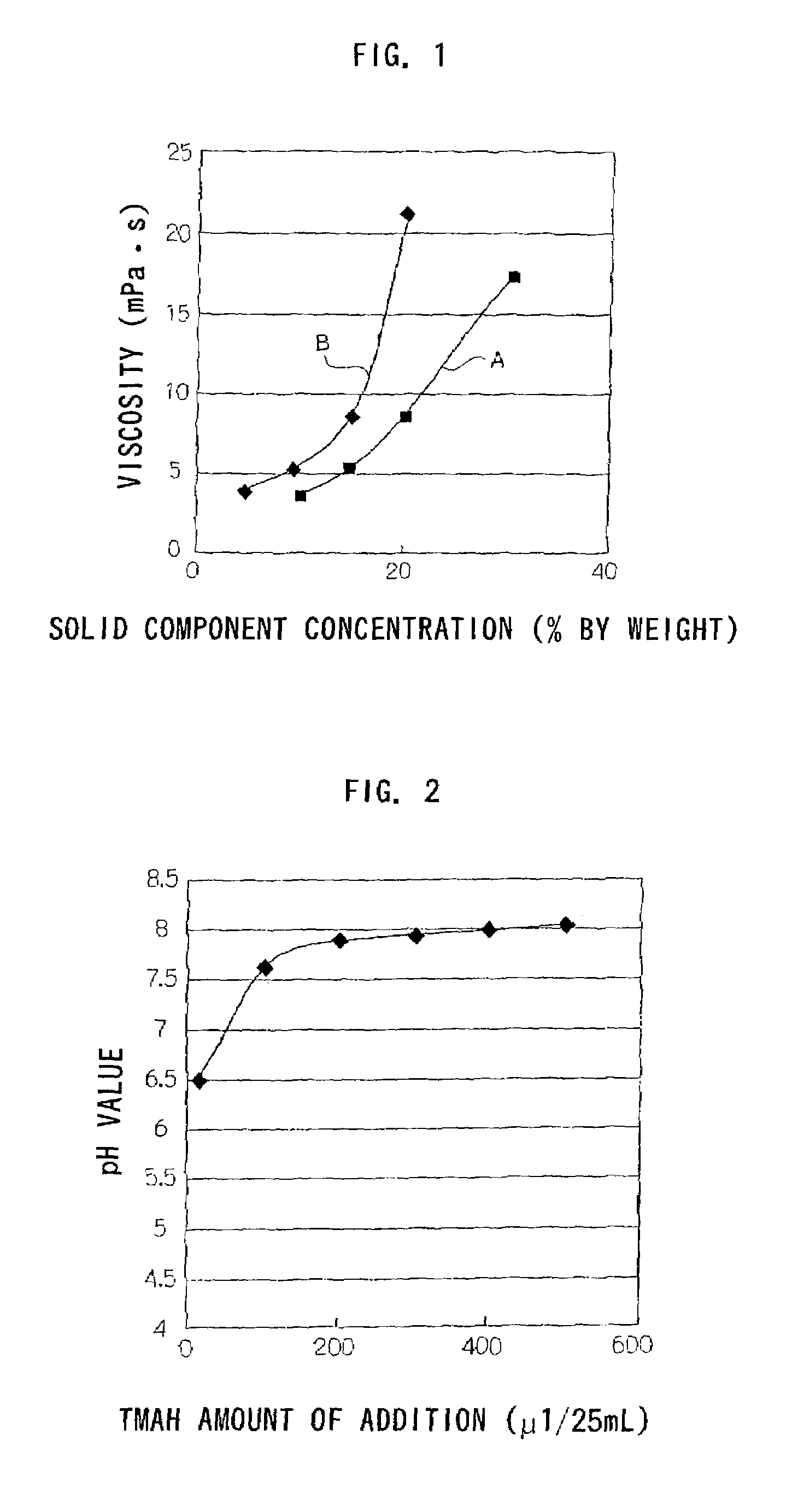Aqueous ink composition, manufacturing method therefor and image forming method using the same
a technology of ink composition and manufacturing method, applied in the field of ink composition, can solve the problems of poor water resistance, insufficient pigment dispersion, and current techniques that do not provide adequate image properties for practical use, and achieve the effect of binder, stably dispersing pigment, and increasing the density of pigmen
- Summary
- Abstract
- Description
- Claims
- Application Information
AI Technical Summary
Benefits of technology
Problems solved by technology
Method used
Image
Examples
example 1
[0115]A copolymer (200 g) (random ternary copolymer of styrene-acrylic acid-hexyl acrylate: weight-average molecular weight 19,000, copolymer ratio (weight)=36 / 18 / 46, acid value 120, glass transition point 55° C., fluidity starting point 90° C., decomposition point 237° C., deposition starting point pH 5.8), 750 g of distilled water and 21 g of potassium hydroxide are gradually dissolved while being mixed, and the resulting solution is subjected to a dissolving and colloid-solution preparing process by using a three-one motor propeller stirring device for 5 hours and 30 minutes while being heated to 89° C. Finally, the solution is concentration-adjusted to prepare a colloid water solution having a solid-component concentration of 20% by weight (with an average colloid diameter of 52 nm, pH 8.1).
[0116]This colloid solution and a copper phthalocyanine blue ultra-fine particle pigment (primary average particle size: 32 nm) are mixed at a solid component ratio of 4:6, and to this is add...
example 2
[0133]A copolymer (450 g) (block copolymer of α-methyl styrene-acrylic acid-butyl acrylate: weight-average molecular weight 9,000, copolymer ratio (weight)=30 / 15 / 50, acid value 108, glass transition point 39° C., fluidity starting point 76° C., decomposition starting point 209° C., deposition starting point pH 6.2), 1000 g of distilled water and 200 g of tetramethyl ammonium hydroxide (25% by weight water solution) are dissolved while being mixed, and the resulting solution is subjected to a dissolving and colloid-solution preparing process by using a three-one motor propeller stirring device for 4 hours while being heated to 90° C. Finally, the solution is concentration-adjusted to prepare a colloid water solution having a solid-component concentration of 40% by weight (with an average colloid diameter of 80 nm, pH 8.2).
[0134]This colloid solution and a copper phthalocyanine blue ultra-fine particle pigment are mixed at a solid component ratio of 5:5, and mixed and dispersed by usi...
example 3
[0137]A copolymer (400 g) (block copolymer of α-methyl styrene-methacrylic acid-butyl methacrylate: weight-average molecular weight 17,000, copolymer ratio (weight)=36 / 14 / 50, acid value 111, glass transition point 75° C., fluidity starting point 104° C., decomposition starting point 235° C., deposition starting point pH 6.2), 11 g of potassium hydroxide and 1700 g of distilled water are dissolved while being mixed, and the resulting solution is subjected to a dissolving and colloid-solution preparing process by carrying out a high-strength forceful stirring process using a three-one motor propeller stirring device for 6 hours while being heated to 90° C. Finally, the solution is concentration-adjusted to prepare a colloid water solution having a solid-component concentration of 20% by weight (with an average colloid diameter of 32 nm, pH 8.1).
[0138]Next, this colloid solution and an azo-based red ultra-fine particle pigment are mixed at a solid component ratio of 8:2, and to this is...
PUM
| Property | Measurement | Unit |
|---|---|---|
| Temperature | aaaaa | aaaaa |
| Temperature | aaaaa | aaaaa |
| Temperature | aaaaa | aaaaa |
Abstract
Description
Claims
Application Information
 Login to View More
Login to View More - R&D
- Intellectual Property
- Life Sciences
- Materials
- Tech Scout
- Unparalleled Data Quality
- Higher Quality Content
- 60% Fewer Hallucinations
Browse by: Latest US Patents, China's latest patents, Technical Efficacy Thesaurus, Application Domain, Technology Topic, Popular Technical Reports.
© 2025 PatSnap. All rights reserved.Legal|Privacy policy|Modern Slavery Act Transparency Statement|Sitemap|About US| Contact US: help@patsnap.com

